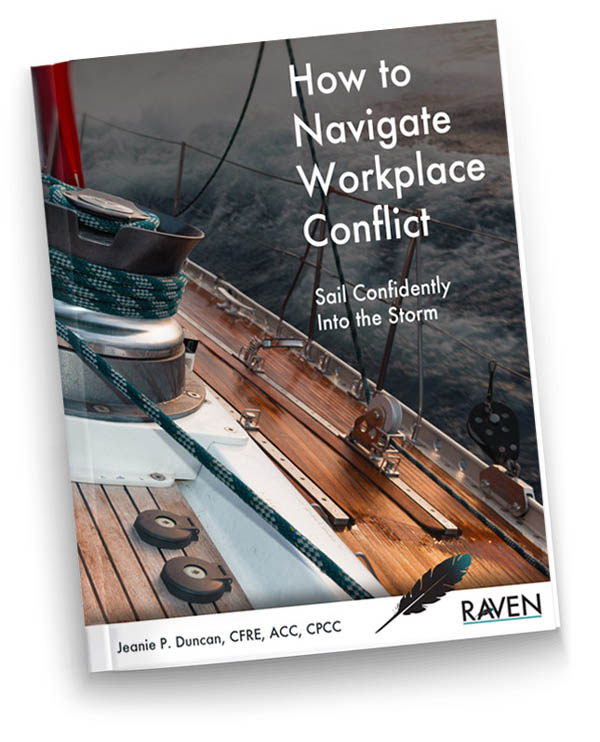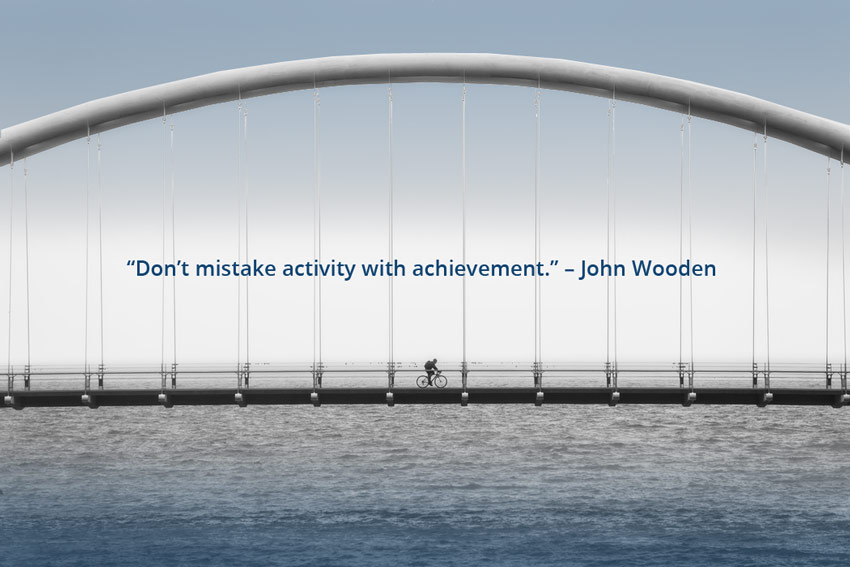
Sep 14, 2016 | Conflict Management, Leadership, Management
 I’ve noticed that so many conversations in the organizations I consult with revolve around conflict in one way or another. Whether it stems from unhealthy “competition” among peers, an ineffective management approach, or frustration from the bottom up, navigating conflict is challenging. It is just human nature to avoid conflict, particularly in the conflict-averse United States, where it’s usually our last resort to attend directly to the issues, tensions, and challenges at the heart of conflict.
I’ve noticed that so many conversations in the organizations I consult with revolve around conflict in one way or another. Whether it stems from unhealthy “competition” among peers, an ineffective management approach, or frustration from the bottom up, navigating conflict is challenging. It is just human nature to avoid conflict, particularly in the conflict-averse United States, where it’s usually our last resort to attend directly to the issues, tensions, and challenges at the heart of conflict.
My clients are often relieved to learn that conflict management – and conflict resolution – are not doomed. In fact, building collaborative teams that can work through potentially challenging situations together is remarkably simple. It just takes a lot of practice, commitment, and perseverance.
In my new ebook, How to Navigate Workplace Conflict: Sail Confidently into the Storm, I’ve collected some of the best advice, techniques, and tips for managing conflict instead of avoiding it. Conflict in the workplace is normal and sometimes even necessary. The ability to have healthy, productive conflict is the sign of a mature, sustainable relationship. To develop your team’s conflict management abilities, you first must establish strong, vulnerability-based trust among the various members of your team. You must establish clear alignment among goals and expectations for the team and everyone on it, learn how to integrate and consider varying perspectives and personality types in envisioning solutions, and bridge the divides among individuals and functional groups.
If you would like to focus on improving your conflict management behaviors and you’re open to learning some practical tools for doing just that, please click here to receive your free copy (for a limited time) of my new ebook, How to Navigate Workplace Conflict: Sail Confidently into the Storm.
The first 10 respondents will also get a free half-hour strategy session with Raven Consulting Group.
 About Jeanie Duncan: Jeanie is President of Raven Consulting Group, a business she founded that focuses on organizational change and leadership development in the nonprofit sector. She is a senior consultant for Raffa, a national firm working with nonprofit clients to lead efforts in sustainability and succession planning, executive transition and search. Additionally, Jeanie serves as adjunct faculty for the Center for Creative Leadership, a top-ranked, global provider of executive leadership education.
About Jeanie Duncan: Jeanie is President of Raven Consulting Group, a business she founded that focuses on organizational change and leadership development in the nonprofit sector. She is a senior consultant for Raffa, a national firm working with nonprofit clients to lead efforts in sustainability and succession planning, executive transition and search. Additionally, Jeanie serves as adjunct faculty for the Center for Creative Leadership, a top-ranked, global provider of executive leadership education.

May 5, 2013 | Intention, Management
 There is a great myth that most of us will fall prey to at some point: if you do more, you will get more. Not always true. I don’t know about you, but I often get caught in the trap of pressing harder, faster, and with greater intensity to try and accomplish a task or achieve a particular goal or deadline. I somehow trick myself into thinking that working harder and doing more is what’s needed to get the job done. Intellectually, I can rationalize the truth in this. But, at a deeper level, I realize that intense effort and pace often depletes my energy, can adversely impact my output, and removes the joy from my work. To help combat this tendency, I have adopted some practices I find beneficial and that have helped me most: Spend the first hour of the day setting priorities and getting organized. It’s easy to launch into the day reacting to the urgent – the rain of emails, interruptions from co-workers, and the barrage of phone calls – rather than advancing the important. I like to get an early start to the day and establish priorities. I begin with the question: “What are the three most important things I need to accomplish today to advance my key goals?” Everything else is a “nice to have.” These three daily priorities all roll up to support my weekly, monthly, and quarterly goals. Focus on the important tasks first. Once I frame my day in the first hour, I immediately set out to accomplish the top three priorities before distractions have a chance to pull me away. If I can’t take care of them all, I’ll make an appointment on my calendar to return to it later in the day. Single-Task. When I’m doing too much, I’m constantly switching from one task to another, experiencing multiple interruptions and distractions. Despite our culture’s demand to multi-task, resist the temptation, clear away distractions, and give attention to the single matter that is most important. Eliminate non-essential commitments. Examine your day or week and ask yourself: “What can I eliminate or delegate? Is that task, meeting, or luncheon something that I absolutely must do? How does it advance my strategic goals?” I try and say no to any request that distracts me from focusing on what’s most important. I think of it as focusing on my highest and best use. Step away and take a break. We all have those occasions when work calls for added effort. But more often than not, simply stepping away and taking a break – like going for a run or having lunch in a park – can infuse new energy, bring fresh perspective and new ideas, and actually enhance productivity. Ask key questions. Another tactic I find helpful is pausing to ask a few critical questions to help me determine priorities or my approach as I begin a particular project or task. It’s an important skill for anyone focused on improving performance, and it can help filter through all the distractions and get to the one thing that will deliver the result. For example:
There is a great myth that most of us will fall prey to at some point: if you do more, you will get more. Not always true. I don’t know about you, but I often get caught in the trap of pressing harder, faster, and with greater intensity to try and accomplish a task or achieve a particular goal or deadline. I somehow trick myself into thinking that working harder and doing more is what’s needed to get the job done. Intellectually, I can rationalize the truth in this. But, at a deeper level, I realize that intense effort and pace often depletes my energy, can adversely impact my output, and removes the joy from my work. To help combat this tendency, I have adopted some practices I find beneficial and that have helped me most: Spend the first hour of the day setting priorities and getting organized. It’s easy to launch into the day reacting to the urgent – the rain of emails, interruptions from co-workers, and the barrage of phone calls – rather than advancing the important. I like to get an early start to the day and establish priorities. I begin with the question: “What are the three most important things I need to accomplish today to advance my key goals?” Everything else is a “nice to have.” These three daily priorities all roll up to support my weekly, monthly, and quarterly goals. Focus on the important tasks first. Once I frame my day in the first hour, I immediately set out to accomplish the top three priorities before distractions have a chance to pull me away. If I can’t take care of them all, I’ll make an appointment on my calendar to return to it later in the day. Single-Task. When I’m doing too much, I’m constantly switching from one task to another, experiencing multiple interruptions and distractions. Despite our culture’s demand to multi-task, resist the temptation, clear away distractions, and give attention to the single matter that is most important. Eliminate non-essential commitments. Examine your day or week and ask yourself: “What can I eliminate or delegate? Is that task, meeting, or luncheon something that I absolutely must do? How does it advance my strategic goals?” I try and say no to any request that distracts me from focusing on what’s most important. I think of it as focusing on my highest and best use. Step away and take a break. We all have those occasions when work calls for added effort. But more often than not, simply stepping away and taking a break – like going for a run or having lunch in a park – can infuse new energy, bring fresh perspective and new ideas, and actually enhance productivity. Ask key questions. Another tactic I find helpful is pausing to ask a few critical questions to help me determine priorities or my approach as I begin a particular project or task. It’s an important skill for anyone focused on improving performance, and it can help filter through all the distractions and get to the one thing that will deliver the result. For example:
- What do I want?
- Why?
- How will I know when I achieve it?
- What can I do to achieve that outcome?
- What can I learn from others who have gone before me?
- What do I bring from prior experiences that can help inform my present situation?
Challenge yourself this week to do less, focus on what’s most important, and discover greater meaning and success in your work. Notice what happens!
“Don’t mistake activity with achievement.” – John Wooden
Jeanie is President of Raven Consulting Group, a business she founded that focuses on organizational change and leadership development in the nonprofit sector. She is a senior consultant for TransitionGuides, a national firm working with nonprofit clients to lead efforts in sustainability and succession planning, executive transition and search. Additionally, Jeanie serves as adjunct faculty for the Center for Creative Leadership.

Nov 10, 2012 | Creativity, Management
 About a month ago, I started putting an appointment on my calendar each week called “Time to Think.” Don’t laugh. Stay with me for three minutes…
About a month ago, I started putting an appointment on my calendar each week called “Time to Think.” Don’t laugh. Stay with me for three minutes…
When do you make time to just think? Devoting dedicated, uninterrupted time to think about your business strategy, debrief learnings about a recent project, or assess progress and refine your plans? Maybe you can relate – I get so wrapped up in my day-to-day and the “doing” of my work, that time to plan and strategize often gets pushed aside.
So I decided to make a weekly two-hour appointment to reflect over the last week and look ahead to the next. I ask myself a series of questions, like: What went well? What can I leverage to produce even greater results? What didn’t go well, and why? What brought me the most joy in my work? And on the contrary, what gave me the biggest headache?
In just four weeks, this “thinking” appointment actually seems to expand time. I thought it would be so hard to dedicate the time and stick with it. I was sure that client projects and priorities would override this new commitment and I’d fall off. And that the anticipated benefit would turn out to be fluff. Not true! I’ve experienced immediate, powerful benefits.
– Before, I never stopped to examine all that I actually accomplish in a week. Probably like you, I move quickly from one thing to the next, and it all blends together. This new commitment has taught me that taking the time to reflect (and also to celebrate the “wins”) is meaningful and has a direct, positive impact on my business and on me personally.
– By simply paying attention, I’m noticing things and becoming more efficient. I’ve outsourced or eliminated tasks and changed the way I prioritize and invest in what matters most. Its as if I have more time and other resources.
– It reminds me that I have the power to choose…to create the life I most want to live. I firmly believe that we create that to which we give thought.
– In my work, I love innovation – experimenting and trying new things, then observing its affect. In doing so, it’s beneficial to reflect on what worked and what didn’t and use those findings to inform future action.
I agree that this isn’t some wild, new idea. But for me, this simple action is yielding some very meaningful results. Give it a try and see what happens. I think it might surprise you!
Jan 29, 2012 | Management
When a nonprofit organization experiences a leadership transition, hiring an interim executive director can be the most logical and positive action its board can take.
Leadership change is an increasingly common aspect of nonprofit organizational life. Multiple studies reinforce the impending turnover of top leadership in the nonprofit sector, due in great part to the aging and retiring boomer population. It’s not a matter of if, but when the change is coming. When your organization experiences this transition, research and practice suggests that groups that plan well and use a skilled interim executive director, emerge stronger, more fiscally sound, and with higher levels of optimism about the future impact of their programs and services.
Leadership transition is a period commonly marked with emotion, tension, and stress. Internally, staff and board are in the midst of separating from the previous executive, and the departing director is in an in-between state and can be confused about how much influence he or she wants or should have on the agency’s future. If the director’s departure is forced, emotions may be particularly high.
Externally, some funders, donors, and volunteers will take a “wait and see” approach before becoming involved and investing in the organization. This can create strain between needs and resources, further taxing administrative systems.
A highly skilled interim executive director temporarily takes the helm of an organization, helps the board and staff address important systems and capacity issues, and lays the groundwork for the following leader’s success. This leader:
– Serves as a bridge, giving the board ample time to conduct a thoughtful search process and managing the day-to-day executive responsibilities that include: conducting an objective organizational review, leading anxious staff, reassuring wary funders, and keeping finances and revenue generation on track.
– Tackles unique challenges related to the transition, building on strengths and addressing particular vulnerabilities.
– Helps the board clarify its vision and future leadership needs.
– Models excellence in management and leadership.
– Mentors the new executive director once appointed.
When considering hiring an interim executive director for your organization:
– Begin with the end in mind. Your board should determine what it wants and needs and what is most critical to success over the next few months.
– Identify urgent issues or challenges presently facing your organization.
– Review the current executive director’s job description, determine priorities for the transition period, and draft an Interim job description.
– Seek an interim executive director with solid management experience and a transition skillset. This takes precedence over familiarity with your organization or industry.
– Consider that the assignment is both temporary (four-eight months) and part-time (20 – 25 hours/week) and that the individual should not be a candidate for the full-time position.
– Realize that, due to the unique demands of the role, interim executives are almost always paid higher on an hourly basis than the agency’s permanent executive (although, most interims are part-time and do not receive normal agency benefits).
– Tap local resources for potential candidates, such as area college nonprofit degree programs, consultants serving the nonprofit sector, industry sector affinity groups, and nonprofit consortiums.
There is great power and potential in this “neutral zone” – the space after the former director leaves and the new leader begins. The organization is more open to change than usual and poised to leverage the heightened opportunity. Systems and culture become a bit “unglued” and can be put back together in new and exciting ways that leave the nonprofit stronger and more sustainable.

 I’ve noticed that so many conversations in the organizations I consult with revolve around conflict in one way or another. Whether it stems from unhealthy “competition” among peers, an ineffective management approach, or frustration from the bottom up, navigating conflict is challenging. It is just human nature to avoid conflict, particularly in the conflict-averse United States, where it’s usually our last resort to attend directly to the issues, tensions, and challenges at the heart of conflict.
I’ve noticed that so many conversations in the organizations I consult with revolve around conflict in one way or another. Whether it stems from unhealthy “competition” among peers, an ineffective management approach, or frustration from the bottom up, navigating conflict is challenging. It is just human nature to avoid conflict, particularly in the conflict-averse United States, where it’s usually our last resort to attend directly to the issues, tensions, and challenges at the heart of conflict. About Jeanie Duncan: Jeanie is President of Raven Consulting Group, a business she founded that focuses on organizational change and leadership development in the nonprofit sector. She is a senior consultant for Raffa, a national firm working with nonprofit clients to lead efforts in sustainability and succession planning, executive transition and search. Additionally, Jeanie serves as adjunct faculty for the Center for Creative Leadership, a top-ranked, global provider of executive leadership education.
About Jeanie Duncan: Jeanie is President of Raven Consulting Group, a business she founded that focuses on organizational change and leadership development in the nonprofit sector. She is a senior consultant for Raffa, a national firm working with nonprofit clients to lead efforts in sustainability and succession planning, executive transition and search. Additionally, Jeanie serves as adjunct faculty for the Center for Creative Leadership, a top-ranked, global provider of executive leadership education.



Recent Comments